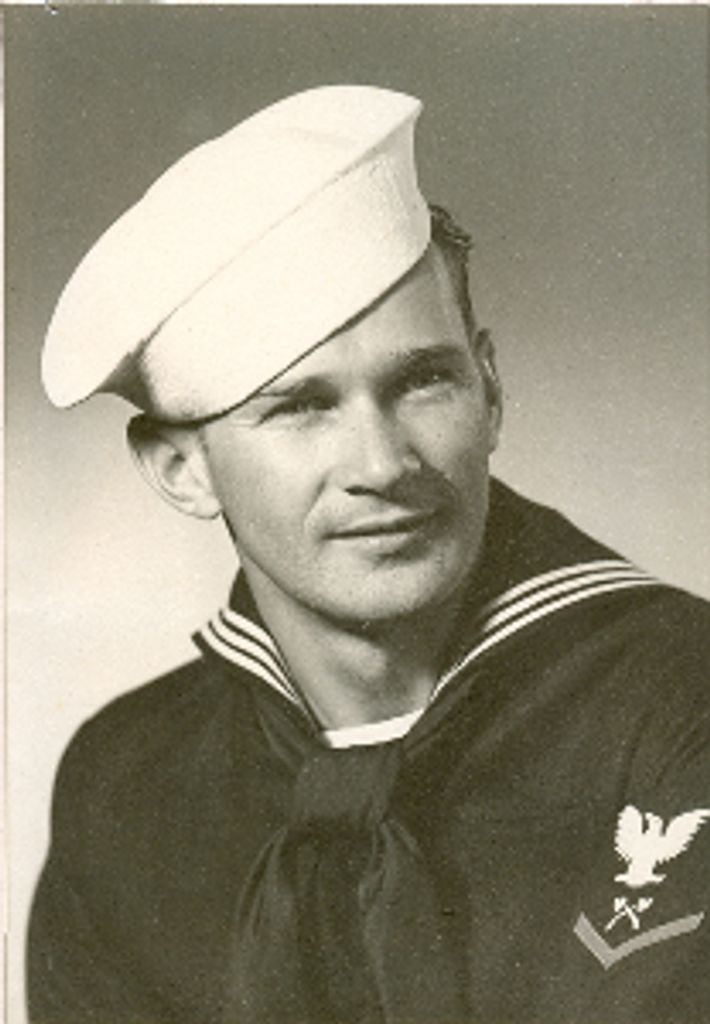

In Memory Of
John Herget
John Herget
Listen to Obituary
John Rogers (Jack) Herget was born in Cincinnati, Ohio, the eldest of three children, to a doting mother and father. It was a difficult birth which both mother and child barely survived. The doctor set the baby aside to devote his attentions to the mother; but Jack's father worked feverishly to revive him, and after many anxious moments, his efforts paid off with the resounding wail of a living child.
During Jack's first decade of life, the family enjoyed prosperity and ease, due to his father's investment successes. However, with the 1929 stock market crash and the ensuing Great Depression, they lost everything. Jack moved with his mother and two sisters to San Antonio, and ultimately to McAllen, in the Rio Grande Valley of Southern Texas, while his father struggled to find work in Ohio and send whatever he could to his wife and children. John Sr. was considered a born salesman and eventually did find work, introducing the dry cell battery to the South. It was an exciting idea, and all of the farmers wanted it badly, but in those depressed economic times, no one could afford it. It was another business venture gone awry.
Despite the poverty the family endured during those years, they were not alone in their plight—no one they knew had money. One year, Jack did not have a single pair of shoes to wear, but in the subtropical climate of the Valley, going to school barefoot was not unusual. Like most Catholic boys, he was an altar server at the nearby church and often spoke fondly of La Lomita Chapel in Mission, Tex., an important site for the Oblate missionaries, which still stands today.
At age 11, Jack went to work to help support the family, taking whatever odd jobs he could find, until he eventually was hired as a "curb hop" at the New Way, a popular restaurant that provided drive-in service. His starting wage was 10 cents an hour with tips, and he often worked 10-hour days—a fabulous wage for the time, but a very long schedule for a boy his age.
Summers were an idyllic time for Jack. He was an avid Boy Scout, and having learned a number of self-reliance skills in scouting, he camped out alone, beginning at age 12, along the Rio Grande River separating Texas from Mexico. Each year he built a lean-to, created a bed from tree boughs, and cooked on a campfire, his beloved German shepherd Jick his closest companion. Although his family occasionally brought him a few staples, most of his food came from whatever small animals or fish he caught. His best friends were Mexican boys from the neighboring farms, who were perhaps even poorer than his own family, but he was always a welcome guest in their homes. He taught them English, and learned enough Spanish from them to get by reasonably well. One family gave him a mustang, which he named Chacho, but it was not easy to tame the horse's wild nature, and out of sheer meanness, he said, the capricious Chacho threw him into the grapefruit trees of the nearby citrus orchards, or dumped him unceremoniously in the cactus plants at every opportunity.
In 1940 Jack met a captivating girl named Judy, and they were soon married. Jack found work as a roofer in Houston, so they moved there to share a home with Jack's mother and dad. Following the birth of daughter Joyce in July 1941, the couple moved back to the Valley, where Jack began working as a sheet metal pattern draftsman. By the fall of 1944, with World War II well underway, he decided to enlist in the U.S. Navy and was stationed at the Naval Training Station in San Diego until spring 1946. He applied for submarine duty, but the Navy denied his request, citing his wife and dependent child as the reason for denial. Instead, he became a Carpenter's Mate, Second Class, in support of the war effort.
Following his discharge in 1946, the family again returned to the Rio Grande Valley, where Jack resumed his sheet metal work, which he always found challenging and satisfying. He tackled every job as if it were a work of art, with every seam and fitting having to be perfect, and often tried to describe and sketch his projects in intricate and technical detail to his bemused wife and daughter.
In 1953, the three moved to Colorado Springs, and Jack quickly found work in his field. He became an avid skier, fished a hundred mountain streams and ponds, studied geology and became a "rock hound," collecting dozens of specimens which he could readily identify by name. And, as always, he loved the Spanish language, the Mexican people, and their culture and traditions.
Following his retirement in the mid-1970s, Jack became active in Alcoholics Anonymous and worked with numerous people striving to overcome their addictions. He also continued to enjoy fishing and gardening. During this time, he and Judy took over a dozen cruises, to the Caribbean, Alaska, the Panama Canal, St. Lawrence Seaway, and down the Amazon River.
Jack is survived by his wife of 70 years, Judy; his daughter Joyce (Marvin) Hersh; granddaughter Garen (Thomas) Hughes-Garcia; great-grandchildren Miranda Carey and Paul Garcia; and nieces Tricia Stearns, Marci Woolf and Donna Hengst, all of San Antonio. He was preceded in death by his sisters Anne Foster and Patsy Switzer.
During Jack's first decade of life, the family enjoyed prosperity and ease, due to his father's investment successes. However, with the 1929 stock market crash and the ensuing Great Depression, they lost everything. Jack moved with his mother and two sisters to San Antonio, and ultimately to McAllen, in the Rio Grande Valley of Southern Texas, while his father struggled to find work in Ohio and send whatever he could to his wife and children. John Sr. was considered a born salesman and eventually did find work, introducing the dry cell battery to the South. It was an exciting idea, and all of the farmers wanted it badly, but in those depressed economic times, no one could afford it. It was another business venture gone awry.
Despite the poverty the family endured during those years, they were not alone in their plight—no one they knew had money. One year, Jack did not have a single pair of shoes to wear, but in the subtropical climate of the Valley, going to school barefoot was not unusual. Like most Catholic boys, he was an altar server at the nearby church and often spoke fondly of La Lomita Chapel in Mission, Tex., an important site for the Oblate missionaries, which still stands today.
At age 11, Jack went to work to help support the family, taking whatever odd jobs he could find, until he eventually was hired as a "curb hop" at the New Way, a popular restaurant that provided drive-in service. His starting wage was 10 cents an hour with tips, and he often worked 10-hour days—a fabulous wage for the time, but a very long schedule for a boy his age.
Summers were an idyllic time for Jack. He was an avid Boy Scout, and having learned a number of self-reliance skills in scouting, he camped out alone, beginning at age 12, along the Rio Grande River separating Texas from Mexico. Each year he built a lean-to, created a bed from tree boughs, and cooked on a campfire, his beloved German shepherd Jick his closest companion. Although his family occasionally brought him a few staples, most of his food came from whatever small animals or fish he caught. His best friends were Mexican boys from the neighboring farms, who were perhaps even poorer than his own family, but he was always a welcome guest in their homes. He taught them English, and learned enough Spanish from them to get by reasonably well. One family gave him a mustang, which he named Chacho, but it was not easy to tame the horse's wild nature, and out of sheer meanness, he said, the capricious Chacho threw him into the grapefruit trees of the nearby citrus orchards, or dumped him unceremoniously in the cactus plants at every opportunity.
In 1940 Jack met a captivating girl named Judy, and they were soon married. Jack found work as a roofer in Houston, so they moved there to share a home with Jack's mother and dad. Following the birth of daughter Joyce in July 1941, the couple moved back to the Valley, where Jack began working as a sheet metal pattern draftsman. By the fall of 1944, with World War II well underway, he decided to enlist in the U.S. Navy and was stationed at the Naval Training Station in San Diego until spring 1946. He applied for submarine duty, but the Navy denied his request, citing his wife and dependent child as the reason for denial. Instead, he became a Carpenter's Mate, Second Class, in support of the war effort.
Following his discharge in 1946, the family again returned to the Rio Grande Valley, where Jack resumed his sheet metal work, which he always found challenging and satisfying. He tackled every job as if it were a work of art, with every seam and fitting having to be perfect, and often tried to describe and sketch his projects in intricate and technical detail to his bemused wife and daughter.
In 1953, the three moved to Colorado Springs, and Jack quickly found work in his field. He became an avid skier, fished a hundred mountain streams and ponds, studied geology and became a "rock hound," collecting dozens of specimens which he could readily identify by name. And, as always, he loved the Spanish language, the Mexican people, and their culture and traditions.
Following his retirement in the mid-1970s, Jack became active in Alcoholics Anonymous and worked with numerous people striving to overcome their addictions. He also continued to enjoy fishing and gardening. During this time, he and Judy took over a dozen cruises, to the Caribbean, Alaska, the Panama Canal, St. Lawrence Seaway, and down the Amazon River.
Jack is survived by his wife of 70 years, Judy; his daughter Joyce (Marvin) Hersh; granddaughter Garen (Thomas) Hughes-Garcia; great-grandchildren Miranda Carey and Paul Garcia; and nieces Tricia Stearns, Marci Woolf and Donna Hengst, all of San Antonio. He was preceded in death by his sisters Anne Foster and Patsy Switzer.
To order memorial trees or send flowers to the family in memory of John Herget, please visit our flower store.
Service Schedule
Past Services
Service
St. Mark Catholic Church
Guestbook
Visits: 15
This site is protected by reCAPTCHA and the
Google Privacy Policy and Terms of Service apply.
Service map data © OpenStreetMap contributors



